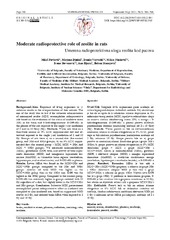Приказ основних података о документу
Moderate radioprotective role of zeolite in rats
Umerena radioprotektivna uloga zeolita kod pacova
| dc.creator | Pavlović, Miloš | |
| dc.creator | Đukić, Mirjana | |
| dc.creator | Vojvodić, Danilo | |
| dc.creator | Ninković, Milica | |
| dc.creator | Stevanović, Ivana | |
| dc.creator | Đurić, Ana | |
| dc.creator | Stanojević, Boban | |
| dc.date.accessioned | 2021-09-15T08:40:32Z | |
| dc.date.available | 2021-09-15T08:40:32Z | |
| dc.date.issued | 2021 | |
| dc.identifier.issn | 0042-8450 | |
| dc.identifier.issn | 2406-0720 (eISSN) | |
| dc.identifier.uri | https://vet-erinar.vet.bg.ac.rs/handle/123456789/2219 | |
| dc.description.abstract | Background/Aim. Exposure of living organisms to γ-radiation results in the overproduction of free radicals. The aim of the study was to test if the subacute administration of micronized zeolite (MZC) accomplishes radioprotective role based on the evaluation of the status of oxidative stress (OS) in the brain and 8-hydroxyguanosine (8-OH-dG) in the plasma of the rats exposed to the single γ-ray irradiation of 2 and/or 10 Gray (Gy). Methods. Wistar rats were on a four-week normal or 5% MZC supplemented diet and afterward exposed to the single γ-ray irradiation of 2 and 10 Gy. Groups of rats were: a) on a normal diet (the control group, and 2Gy and 10Gy groups); b) on 5% MZC supplemented diet (the control group – MZC, MZC + 2Gy, and MZC + 10Gy groups). We measured malondialdehyde (MDA), glutathione (GSH) total, and activity of total super-oxide dismutase (tSOD) and manganese superoxide dismutase (MnSOD) in vulnerable brain regions (cerebellum, hippocampus, and cerebral cortex) and 8-OH-dG in plasma. Results. Lower MDA was found in the MZC+2Gy and MZC+10Gy groups compared to the 2Gy and 10Gy groups. Activity od total SOD was higher in the MZC+10Gy group than in the 10Gy one. GSH was the highest in the 10Gy group. Compared to the control group, 8-OH-dG was extremely higher in groups radiated with 10 Gy regardless of a diet, but slightly lower in the MZC+2Gy and 2Gy groups. Conclusion. Subacute MZC pretreatment accomplished partial radioprotective effect in irradiated rats compared to non-irradiated rats, based on suppressed SOD activity at 2 Gy, and reduced brain MDA when exposed to 2 Gy and 10 Gy. | |
| dc.description.abstract | Background/Aim. Exposure of living organisms to γradiation results in the overproduction of free radicals. The aim of the study was to test if the subacute administration of micronized zeolite (MZC) accomplishes radioprotective role based on the evaluation of the status of oxidative stress (OS) in the brain and 8-hydroxyguanosine (8-OH-dG) in the plasma of the rats exposed to the single γ-ray irradiation of 2 and/or 10 Gray (Gy). Methods. Wistar rats were on a four-week normal or 5% MZC supplemented diet and afterward exposed to the single γ-ray irradiation of 2 and 10 Gy. Groups of rats were: a) on a normal diet (the control group, and 2Gy and 10Gy groups); b) on 5% MZC supplemented diet (the control group – MZC, MZC + 2Gy, and MZC + 10Gy groups). We measured malondialdehyde (MDA), glutathione (GSH) total, and activity of total superoxide dismutase (tSOD) and manganese superoxide dismutase (MnSOD) in vulnerable brain regions (cerebellum, hippocampus, and cerebral cortex) and 8-OH-dG in plasma. Results. Lower MDA was found in the MZC+2Gy and MZC+10Gy groups compared to the 2Gy and 10Gy groups. Activity od total SOD was higher in the MZC+10Gy group than in the 10Gy one. GSH was the highest in the 10Gy group. Compared to the control group, 8-OH-dG was extremely higher in groups radiated with 10 Gy regardless of a diet, but slightly lower in the MZC+2Gy and 2Gy groups. Conclusion. Subacute MZC pretreatment accomplished partial radioprotective effect in irradiated rats compared to non-irradiated rats, based on suppressed SOD activity at 2 Gy, and reduced brain MDA when exposed to 2 Gy and 10 Gy. | |
| dc.publisher | Military Medical Academy | |
| dc.relation | info:eu-repo/grantAgreement/MESTD/Integrated and Interdisciplinary Research (IIR or III)/41018/RS// | |
| dc.relation | the Ministry of Defense of the Republic of Serbia (Projects No.: The structural and molecular aspects of oxidative/ nitrosative stress prevention. MFVМА/01/18-20) supported this study. | |
| dc.rights | openAccess | |
| dc.rights.uri | https://creativecommons.org/licenses/by-sa/4.0/ | |
| dc.source | Vojnosanitetski pregled | |
| dc.subject | brain | |
| dc.subject | oxidative stress | |
| dc.subject | plasma | |
| dc.subject | radiation | |
| dc.subject | ionizing | |
| dc.subject | rats | |
| dc.subject | zeolites | |
| dc.subject | mozak | |
| dc.subject | plazma | |
| dc.subject | pacovi | |
| dc.subject | zeoliti | |
| dc.title | Moderate radioprotective role of zeolite in rats | |
| dc.title | Umerena radioprotektivna uloga zeolita kod pacova | |
| dc.type | article | en |
| dc.rights.license | BY-SA | |
| dcterms.abstract | Станојевић, Бобан; Павловић, Милош; Ђукић, Мирјана; Војводић, Данило; Нинковић, Милица; Стевановић, Ивана; Ђурић, Aна; Умерена радиопротективна улога зеолита код пацова; Модерате радиопротецтиве роле оф зеолите ин ратс; | |
| dc.citation.volume | 78 | |
| dc.citation.issue | 7 | |
| dc.citation.spage | 760 | |
| dc.citation.epage | 768 | |
| dc.citation.rank | M23 | |
| dc.identifier.wos | 000688074000009 | |
| dc.identifier.doi | 10.2298/VSP190702136P | |
| dc.identifier.scopus | 2-s2.0-85114141783 | |
| dc.identifier.fulltext | https://vet-erinar.vet.bg.ac.rs/bitstream/id/6102/0042-84501900136P.pdf | |
| dc.type.version | publishedVersion |

